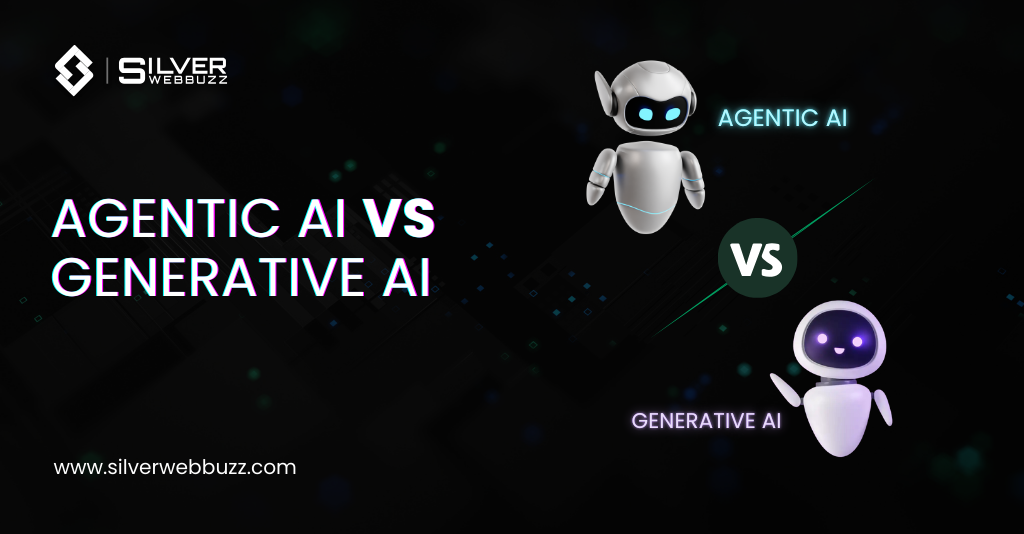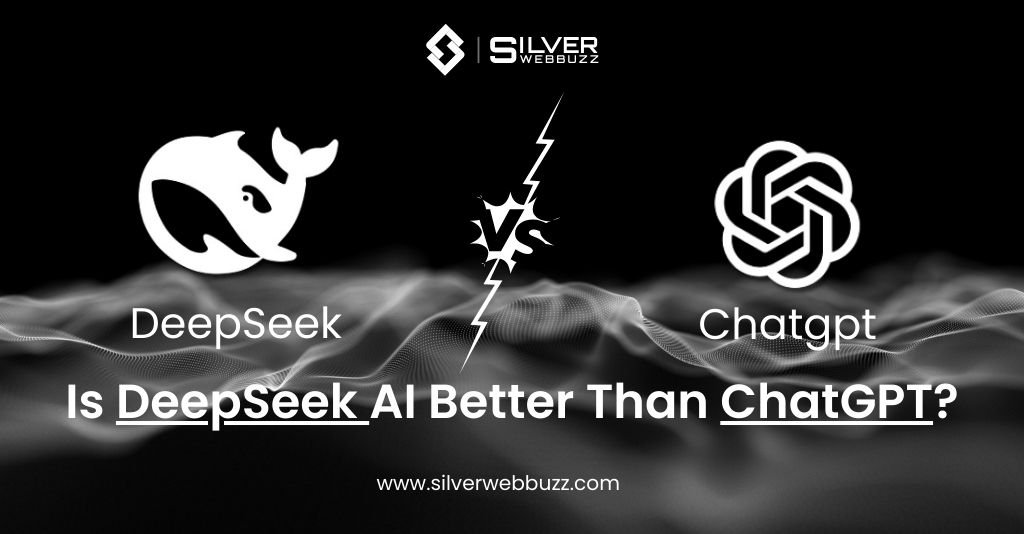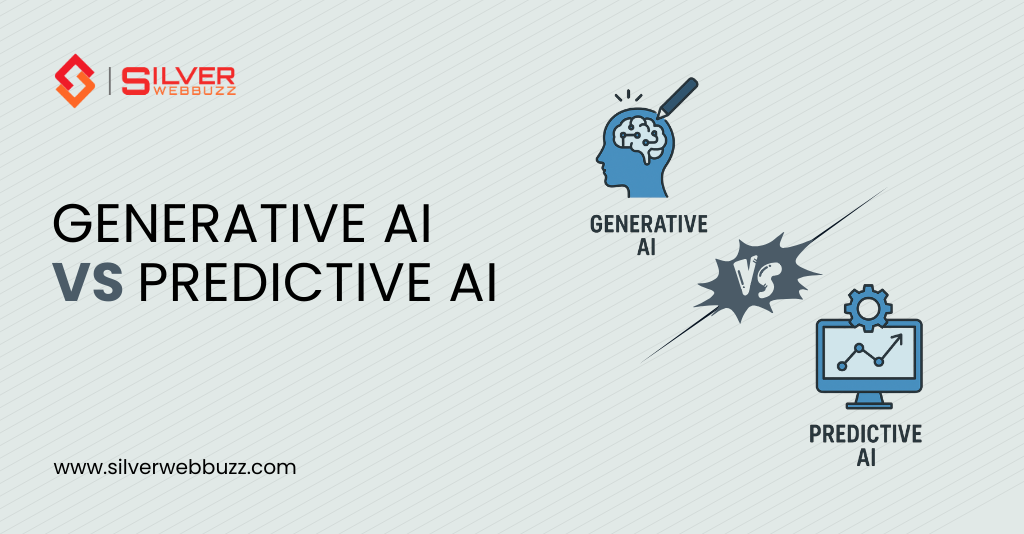Artificial Intelligence (AI) is evolving at an unprecedented pace. Over the past few years, generative AI has taken centre stage, powering chatbots, creating marketing content, writing code, and even generating lifelike images. However, as businesses become increasingly ambitious in their use of AI, a new frontier is emerging: agentic AI.
If generative AI is about producing content, agentic AI is about taking action. It moves beyond text and image generation to decision-making, problem-solving, and autonomous execution. This evolution is transforming how industries—from fintech to healthcare—approach automation and innovation.
So why does this distinction matter?
Because business leaders, founders, and digital innovators need to understand not just what AI can generate, but what AI can decide and do on its own. The difference between these two paradigms will shape how companies build solutions, engage with customers, and unlock efficiency in the years ahead.
What is Generative AI?
Generative AI refers to artificial intelligence systems that can create new content—whether that’s text, images, audio, video, or even code—based on patterns they’ve learned from massive datasets. Unlike traditional AI, which is typically rule-based or limited to analysis, Generative AI focuses on producing original outputs that resemble human-created work.
At the core of Generative AI are machine learning models, especially Large Language Models (LLMs) such as GPT (the model behind ChatGPT) and multimodal models like DALL·E and Stable Diffusion. These systems are trained on vast amounts of data and can “predict” the next word, pixel, or sound to generate meaningful and realistic results.
Generative AI Examples
- Content generation: Writing blog posts, social media captions, product descriptions, or ad copy.
- Image and design creation: Tools like MidJourney or DALL·E that create marketing visuals, product mockups, or illustrations.
- Code generation: Platforms such as GitHub Copilot that help developers write and debug code faster.
- Customer interactions: Chatbots and virtual assistants that can respond naturally to queries.
- Data simulation: Creating synthetic datasets for training machine learning models where real data is scarce.
Generative AI Use Cases in Business
- Fintech: Automating compliance reports, creating personalized financial insights for customers, and generating real-time fraud detection alerts.
- E-commerce: Writing SEO-optimized product descriptions and generating promotional creatives.
- Healthcare: Supporting medical imaging analysis and summarizing research papers.
- Education: Assisting with personalized learning material generation.
Why Generative AI Matters
Generative AI empowers businesses to scale creativity, communication, and content production. Instead of replacing human creativity, it enhances efficiency—enabling teams to focus on higher-level strategy while AI handles repetitive or data-heavy tasks.
However, it has limits: it generates but doesn’t decide. Even with Generative AI Development Services, it needs human prompts. That’s where Agentic AI comes in.
What is Agentic AI?
While Generative AI focuses on creating outputs like text or images, Agentic AI goes a step further: it can take initiative, make decisions, and act autonomously to achieve a goal.
In simple terms, Agentic AI is not just a tool you prompt—it’s an AI agent that can reason, plan, and execute tasks with minimal human intervention. Instead of waiting for explicit instructions, it can evaluate a situation, choose the best course of action, and carry it out—similar to how a human assistant might operate.
This is possible because Agentic AI combines:
- Autonomy: The ability to operate without constant prompts.
- AI decision-making: Evaluating multiple options and selecting the most effective.
- Problem-solving: Using logic and data to reach solutions.
- Integration with tools/systems: Connecting to APIs, software, and workflows to take real action.
Agentic AI Examples
- Autonomous financial advisors: AI systems that don’t just suggest investments, but can automatically rebalance portfolios based on market conditions.
- Customer support agents: Virtual agents that not only respond to questions but also perform actions like resetting accounts, processing refunds, or escalating tickets when necessary.
- AI-driven operations: Supply chain agents that detect disruptions and reroute logistics without human oversight.
- Healthcare assistants: Agents that monitor patient data in real time and autonomously schedule interventions or alerts for medical staff.
- Marketing automation: AI agents that can design campaigns, launch them, monitor performance, and optimize ads—all without step-by-step instructions.
Why Agentic AI Matters
Agentic AI introduces a shift in how businesses use AI. Instead of acting as a supportive tool, it behaves more like a collaborator or team member. For industries like fintech, this means:
- Automating complex compliance workflows.
- Managing risk assessments in real time.
- Executing financial transactions within pre-set guardrails.
The benefit? Businesses save time, reduce errors, and unlock efficiency at a scale not possible with human effort alone.
Where Generative AI creates, Agentic AI acts. This evolution marks a turning point in AI adoption.
Difference Between Agentic AI and Generative AI
Generative AI and Agentic AI often get mentioned together, but their roles are quite distinct. Generative AI is best at creating outputs, while Agentic AI is designed to take action toward outcomes.
<trCore FunctionProduces new content (text, images, code, etc.).Makes decisions and executes actions autonomously.
| Aspect | Generative AI | Agentic AI |
|---|---|---|
| Primary Strength | Creativity, scalability, and content generation. | Autonomy, problem-solving, and real-time decision-making. |
| Human Role | Requires prompts and supervision. | Minimal intervention once guardrails are set. |
| Examples | Writing financial reports, generating product descriptions, creating chatbot responses. | Rebalancing investment portfolios, rerouting logistics, automating loan approvals. |
| Business Impact | Increases efficiency in content and communication. | Transforms operations by reducing manual effort and enabling autonomy. |
| Limitations | Cannot act independently; outputs may need human review. | Risk of over-reliance; requires strict compliance and monitoring. |
Key Takeaway
- Generative AI is like a skilled content creator—it produces high-quality work when asked.
- Agentic AI is like an autonomous manager—it takes initiative, makes choices, and carries out tasks.
- Both are powerful, but the way businesses use them depends on whether they need generation or action.
Business Applications & Opportunities
Both Generative AI and Agentic AI are reshaping industries—but they serve different purposes. Understanding when to use one over the other helps businesses make smarter investments and build more impactful solutions.
Generative AI Use Cases
Generative AI is most valuable where creativity, communication, and data-driven content are needed at scale.
1. Fintech:
- Generating compliance reports from raw financial data.
- Creating personalized customer insights or financial summaries.
- Drafting automated responses for banking chatbots.
2. E-commerce:
- Writing product descriptions optimized for SEO.
- Designing digital creatives for ad campaigns.
- Creating AI-powered virtual try-on images.
3. Healthcare:
- Summarizing medical research papers.
- Generating synthetic patient data for safer model training.
- Supporting patient communication with chatbots.
4. Education:
- Creating personalized learning materials.
- Drafting quizzes or practice exercises.
Agentic AI Applications in Business
Agentic AI becomes essential when businesses need autonomy, decision-making, and real-time execution.
1. Fintech:
- Autonomous advisors that not only recommend but rebalance investments.
- Risk management agents that detect fraud and take immediate preventive actions.
- Loan automation systems that assess creditworthiness and process approvals in real time.
2. E-commerce & Retail:
- AI agents that dynamically adjust prices based on demand.
- Virtual agents that handle returns or refunds without human staff.
- Supply chain agents that reroute deliveries when disruptions occur.
3. Healthcare:
- AI monitoring systems that track patient vitals and autonomously alert doctors.
- Agents that schedule patient follow-ups or medication reminders.
4. Marketing & Sales:
- Campaign agents that design, launch, and optimize ads across platforms.
- Sales assistants that qualify leads and schedule meetings automatically.
Opportunity for Leaders
- Use Generative AI when the goal is to create at scale—content, insights, or design.
- Use Agentic AI when the goal is to automate at scale—decision-making, execution, and operations.
Forward-thinking businesses are starting to combine both approaches: Generative AI for ideation and content, and Agentic AI for execution and follow-through.
Pros and Cons of Agentic AI vs Generative AI
No AI approach is without trade-offs. Both Generative and Agentic AI bring clear advantages, but they also carry risks leaders must understand before adoption.
1. Pros of Generative AI
- Boosts efficiency: Automates repetitive tasks like drafting content, saving time for teams.
- Enhances creativity: Provides fresh ideas, designs, and narratives that humans can refine.
- Scalable output: Generates content on demand at volumes no human team can match.
- Broad accessibility: Available through widely adopted platforms and APIs, lowering the barrier to entry.
2. Cons of Generative AI
- Lacks autonomy: Always requires prompts; cannot act independently.
- Quality control issues: Outputs may contain bias, inaccuracies, or hallucinations.
- Limited context awareness: Struggles with complex, multi-step reasoning or decision-making.
- Data sensitivity risks: May inadvertently generate content based on sensitive or copyrighted information.
3. Pros of Agentic AI
- Autonomous execution: Can take real-world actions with minimal human oversight.
- Stronger problem-solving: Goes beyond content to decision-making and task management.
- Operational efficiency: Handles end-to-end workflows, freeing teams from manual work.
- Real-time adaptability: Responds instantly to new data, conditions, or events.
4. Cons of Agentic AI
- Higher risk factor: Autonomous actions could cause unintended consequences if not carefully monitored.
- Complex implementation: Requires robust integration with systems, guardrails, and governance.
- Regulatory and ethical challenges: Raises compliance issues in industries like finance and healthcare.
- Trust gap: Leaders and teams may hesitate to hand over critical decisions to machines.
Generative AI augments human creativity, while Agentic AI augments human decision-making. To maximize benefits, businesses should adopt a hybrid approach, using each where it fits best while maintaining strong oversight.
The Future of AI: From Generative to Agentic
AI is moving from being a content generator to becoming an autonomous decision-maker. This transition mirrors how businesses evolve: first, they digitize processes; then, they automate; and finally, they delegate decision-making to intelligent systems.
Key Trends to Watch
- Hybrid AI Systems: The most powerful solutions will combine Generative AI’s creativity with Agentic AI’s autonomy. For example, a fintech platform could generate personalized financial insights (generative) and then automatically adjust investment portfolios (agentic).
- AI Autonomy in Workflows: As businesses adopt AI agents, workflows will shift from being human-led with AI support to AI-led with human oversight.
- Integration with Enterprise Tools: Agentic AI will increasingly connect with CRMs, ERPs, and financial systems, enabling direct action instead of static recommendations.
- Regulation and Guardrails: Governments and industry bodies are developing frameworks to ensure autonomous AI operates safely, ethically, and compliantly. Businesses must prepare for stricter oversight.
- Trust Building: Just as Generative AI needed time to gain user trust, Agentic AI will require gradual adoption, transparent testing, and clear boundaries.
How Businesses Can Prepare
- Start small: Experiment with limited-scope AI agents for tasks like customer service, scheduling, or basic financial operations.
- Combine strengths: Use Generative AI for ideation and insights, and Agentic AI for execution. Together, they deliver end-to-end value.
- Build governance: Establish clear policies, compliance checks, and oversight processes for autonomous AI systems.
- Invest in training: Educate teams on working alongside AI agents and using them effectively.
- Think long-term: Instead of short-term fixes, design AI adoption strategies that evolve with technology.
Generative AI gave businesses the power to create at scale. Agentic AI will give them the ability to act at scale. The organizations that embrace this shift early—balancing innovation with governance—will lead the next wave of digital transformation.
Conclusion
The debate of Agentic AI vs Generative AI isn’t about which is “better.” Instead, it’s about understanding what each does best and how businesses can combine them for maximum impact.
- Generative AI excels in creativity and content generation, including writing, designing, coding, and simulating data at scale.
- Agentic AI excels in autonomy and decision-making—acting independently, solving problems, and executing workflows in real-time.
Used together, they form a powerful ecosystem: Generative AI creates, Agentic AI acts. With the expertise of an Artificial Intelligence Development Company, this dual approach enables organizations to innovate faster, automate smarter, and deliver better experiences to their customers.




